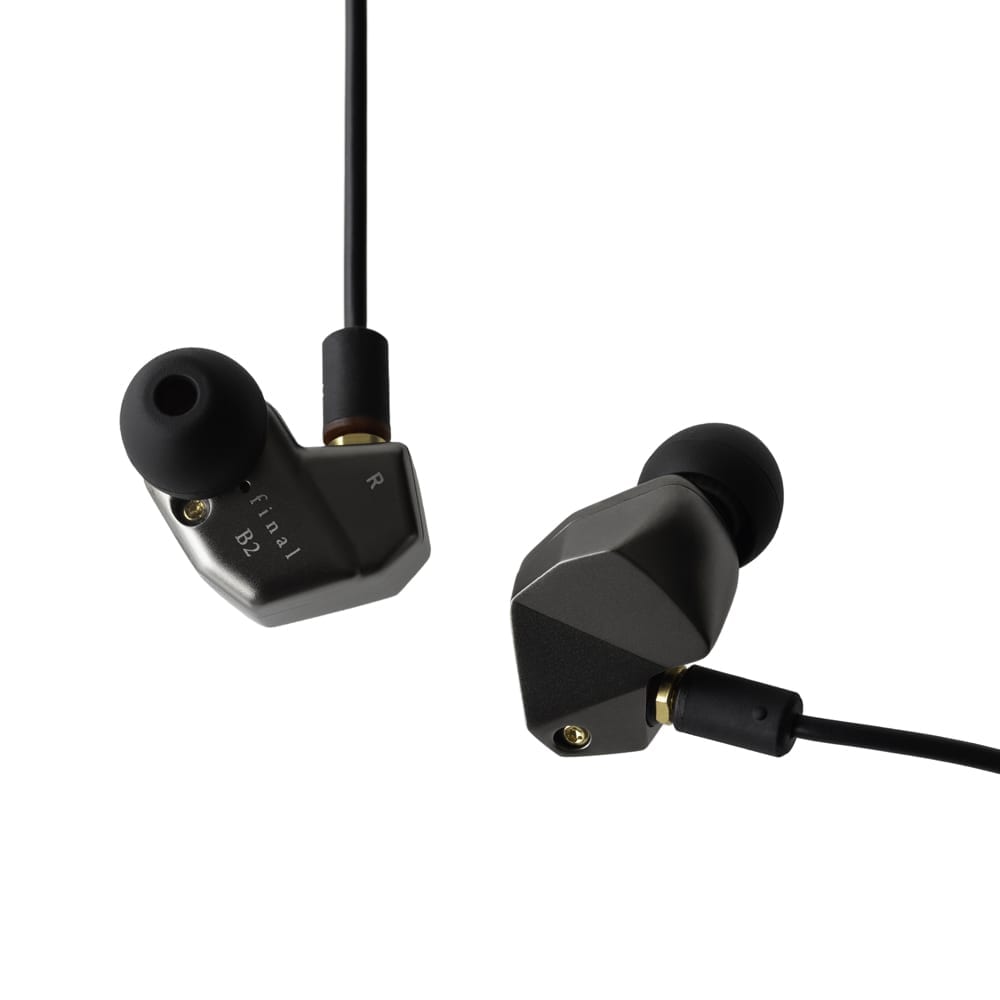B series
Final Audio's latest research and development achievements have evolved into a new series of cutting-edge products.
In this B series, whose name of the models (and their price) is not linked to the usual numerical hierarchy, but rather reflect the order in which the products were developed, a completely new system of cataloging products.
In-Ear Headphones – Final Audio B2
- Housing: Stainless steel (gunmetal finish)
- Speaker type: 1BA
- Connector: MMCX
- Cable: OFC black
- Sensitivity: 109dB
- Impedance: 41Ω
- Weight: 32g
- Cable length: 1.2m
- Sound Characteristics: Voices are reproduced so naturally that the breathing of the performers is perceptible, as are the subtle nuances and timbre of each musical instrument.
B2
The B2s have been designed taking into account the delicate relationship between spatiality and dynamic range, all while respecting the physical characteristics of the headphones.
The voices are reproduced in such a natural way that the breathing of the performers is perceptible, as are the most subtle nuances and the timbre of each musical instrument.
Through research into the relationship between the spatiality, clarity and dynamic range of music recordings and the physical characteristics of earphones and headphones, Final learned that the deepest enjoyment of music can only be achieved by optimizing the frequency response. This objective was achieved by optimizing a driver that best suits the sound of musical recordings.
The B2 is a model particularly appropriate for music with a lot of spatial information. It is well suited, for example, to recordings of classical music that exploit the reflections and reverberations of a concert hall as well as for live events, giving the feeling of “being there”. Furthermore, the B2s use an MMCX connector which allows the cables to be replaced in the event of a fault.

Characteristics
The sound of these headphones has been achieved by taking into account the relationship between the spatial impression and the dynamic range of the music, creating an excellent sound.
The approach was that of spatial perception. Classical and jazz recordings are performed with great emphasis on aspects of spatiality, distance, width and reverberation. Rock, pop, and many recent soundtrack recordings don't really take this into consideration. We prefer to emphasize the clarity of the reproduction, which brings the various instruments and the voice to the fore.
Another approach is dynamic range, i.e. changes in loudness over time. If the dynamic range is large, you can use volume change over time to achieve a more dynamic expression of the music. But there are certain types of music for which recordings with more limited dynamics are preferable, to allow each of the instruments and the voice to appear better before the listener's eyes.
The difference between these two ways of thinking is not about which is better, but rather about how differently music is composed and what is required of the musician. As regards classical in general, and that played by the orchestra in particular, the spatial orientation of the instruments is particularly important. Arched ones are placed closest to the audience with the percussion behind them. If the balance between the spatial orientation and the volume of each group of instruments were to be incorrect, the music would lose its meaning. For this reason, it is not appropriate for every instrument to appear before the listener's eyes. For rock and pop, on the other hand, spatiality is not so necessary and therefore there is more emphasis on clarity than spatiality.
These prerequisites are very important, especially for listening with headphones and earphones, and it is increasingly evident that it is necessary in the design phase to set goals on which aspect to prefer, in order to use the best loudspeaker and the most suitable structure for achieve the project objective.
Let's look at the graph below, where spatiality and clarity of the music are represented on the X-axis and dynamic range on the Y-axis. While the E3000 model was designed with the aim of reaching the center of the graph, the B-series is positioned below outside that area.
In other words, compared to the E series, the B series was created for listening to a specific type of music, and you may be so fascinated by it that you cannot do without it. This characterization is typical of Final products.

Technical specifications






